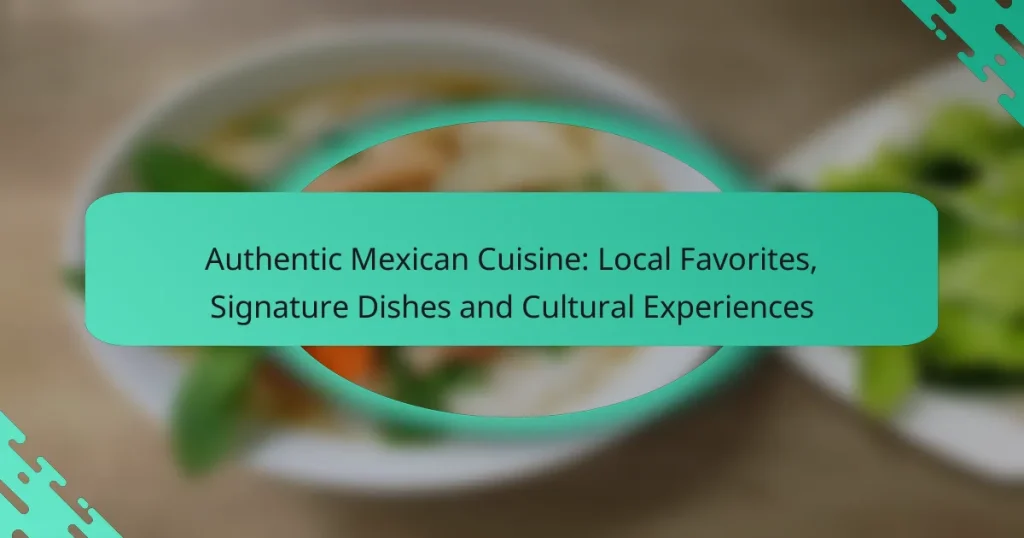Authentic Mexican cuisine offers a vibrant tapestry of flavors and traditions, deeply rooted in the country’s rich cultural heritage. In cities like Los Angeles, restaurants such as Guelaguetza and La Casita Mexicana present signature dishes like Tacos al Pastor and Mole Poblano, inviting diners to explore regional variations and culinary techniques. These dining experiences are further enriched by local customs and music, creating a deeper connection to the stories behind each dish.

What are the best authentic Mexican restaurants in Los Angeles?
Los Angeles is home to numerous authentic Mexican restaurants that showcase traditional flavors and dishes. Some of the best include Guelaguetza, La Casita Mexicana, and El Cholo, each offering unique culinary experiences that reflect Mexico’s rich heritage.
Guelaguetza
Guelaguetza is renowned for its Oaxacan cuisine, particularly its mole dishes and tlayudas. The restaurant emphasizes the use of fresh, local ingredients and traditional cooking methods, making it a favorite among locals and visitors alike.
When dining at Guelaguetza, consider trying their famous mole negro, which is rich and complex, or the tlayuda topped with various meats and fresh vegetables. The vibrant atmosphere and authentic decor enhance the overall dining experience.
La Casita Mexicana
La Casita Mexicana offers a delightful mix of traditional and contemporary Mexican dishes, with a focus on the flavors of the Puebla region. The restaurant is celebrated for its colorful presentation and the use of high-quality ingredients.
Popular menu items include the chiles en nogada and the enchiladas suizas. The warm, inviting ambiance makes it an excellent choice for family gatherings or special occasions.
El Cholo
El Cholo is a classic Mexican restaurant that has been serving authentic dishes since the 1920s. Known for its hearty portions and traditional recipes, it has become a staple in the Los Angeles dining scene.
Signature dishes include the carne asada and the famous green corn tamales. The restaurant’s history and commitment to quality make it a must-visit for anyone seeking genuine Mexican cuisine in the area.

What signature dishes define authentic Mexican cuisine?
Authentic Mexican cuisine is characterized by its rich flavors, diverse ingredients, and traditional cooking methods. Signature dishes such as Tacos al Pastor, Mole Poblano, and Chiles en Nogada showcase the culinary heritage and regional variations found throughout Mexico.
Tacos al Pastor
Tacos al Pastor are a beloved street food in Mexico, known for their marinated pork cooked on a vertical spit, similar to shawarma. The meat is typically seasoned with a blend of spices, including achiote, and served on corn tortillas with onions, cilantro, and pineapple.
When enjoying Tacos al Pastor, look for vendors that prepare their tortillas fresh and use high-quality ingredients. A good taco should have a balance of savory and sweet flavors, enhanced by fresh toppings. Pair them with a squeeze of lime for an extra zing.
Mole Poblano
Mole Poblano is a rich, complex sauce made from a blend of ingredients, including chili peppers, chocolate, spices, and nuts. This signature dish hails from Puebla and is often served over turkey or chicken, making it a festive centerpiece for special occasions.
Preparing Mole Poblano can be labor-intensive, often requiring hours of simmering and blending to achieve the desired depth of flavor. For a simplified version, consider using store-bought mole paste and adding your choice of protein. This dish exemplifies the fusion of indigenous and Spanish culinary traditions.
Chiles en Nogada
Chiles en Nogada is a patriotic dish that features poblano peppers stuffed with a mixture of meat, fruits, and spices, topped with a creamy walnut sauce and pomegranate seeds. This dish is traditionally served during Mexican Independence Day celebrations, symbolizing the colors of the national flag.
When preparing Chiles en Nogada, ensure the peppers are roasted and peeled properly for the best flavor. The filling typically includes ground meat, dried fruits, and spices, creating a harmonious blend of sweet and savory. This dish is best enjoyed fresh, as the flavors meld beautifully when served at room temperature.

How do cultural experiences enhance Mexican dining?
Cultural experiences significantly enhance Mexican dining by immersing diners in the rich traditions and practices that shape the cuisine. Engaging with local customs, music, and cooking methods deepens appreciation for the flavors and stories behind each dish.
Traditional music performances
Traditional music performances play a vital role in enhancing the dining experience in Mexico. Live mariachi bands or folk music groups often accompany meals, creating an inviting atmosphere that celebrates local culture. The lively rhythms and melodies can elevate the enjoyment of food, making meals feel more festive and memorable.
When dining at local restaurants or during festivals, expect to hear a variety of musical styles, from son jarocho to norteño. These performances not only entertain but also connect diners to the cultural heritage of the region, enriching their overall experience.
Cooking classes
Cooking classes offer an interactive way to explore authentic Mexican cuisine. Participants learn to prepare traditional dishes using local ingredients, gaining hands-on experience with techniques that have been passed down through generations. This not only enhances culinary skills but also fosters a deeper understanding of the cultural significance of each dish.
Many cooking classes are available in popular tourist areas, often culminating in a shared meal where participants can enjoy their creations. Look for classes that emphasize regional specialties, such as mole from Oaxaca or seafood dishes from the coastal regions, to truly appreciate the diversity of Mexican flavors.

What ingredients are essential in authentic Mexican cooking?
Essential ingredients in authentic Mexican cooking include fresh corn, various chiles, and cilantro. These components not only define the flavors but also reflect the rich cultural heritage of Mexico.
Fresh corn
Fresh corn is a cornerstone of Mexican cuisine, often used in dishes like tortillas, tamales, and elote. It is typically ground into masa for making tortillas, which are a staple in many meals.
When selecting corn, look for varieties such as white or yellow corn, which are commonly used in traditional recipes. Fresh corn should be sweet and tender, ideally used within a few days of harvesting for the best flavor.
Chiles
Chiles are integral to Mexican cooking, providing heat and depth to dishes. There are numerous varieties, including jalapeño, serrano, and poblano, each offering distinct flavors and heat levels.
When cooking with chiles, consider the desired spice level and the dish’s overall flavor profile. Fresh chiles can be used in salsas, while dried chiles are often rehydrated for sauces. Always taste a small piece first to gauge their heat.
Cilantro
Cilantro adds a fresh, vibrant flavor to many Mexican dishes, from salsas to tacos. It is commonly used as a garnish or incorporated into sauces, enhancing the overall taste profile.
When using cilantro, choose bright green leaves without wilting. For the best flavor, add it towards the end of cooking or use it fresh. Be mindful that some people may find its taste soapy due to genetic factors, so consider alternatives like parsley for those individuals.

How to choose the right Mexican restaurant for special occasions?
Choosing the right Mexican restaurant for special occasions involves considering the atmosphere, menu authenticity, and overall dining experience. Look for venues that align with the occasion’s tone, whether it’s a festive celebration or an intimate gathering.
Consider ambiance and decor
The ambiance and decor of a Mexican restaurant can significantly enhance your dining experience. Look for establishments that feature traditional elements such as colorful papel picado, rustic wooden furniture, and vibrant artwork, which can create a festive atmosphere.
Consider the lighting and seating arrangements as well. For special occasions, a cozy, well-lit space with comfortable seating can make a big difference in how enjoyable the meal will be. Outdoor patios or lively mariachi performances can also add to the festive spirit.
Look for authentic menu options
Authenticity in the menu is crucial when selecting a Mexican restaurant. Seek out places that offer traditional dishes such as mole, tamales, and tacos made with fresh, local ingredients. A diverse menu that includes regional specialties can indicate a commitment to genuine Mexican cuisine.
Check if the restaurant sources its ingredients from local markets or uses family recipes. This not only supports local farmers but also enhances the authenticity of the dishes. Reading reviews or asking locals for recommendations can help you find restaurants that prioritize authentic flavors and cooking methods.

What are the popular regional variations of Mexican cuisine?
Mexican cuisine is rich in regional variations, each with unique ingredients, cooking methods, and flavors. Key regions include Oaxaca, Puebla, and Yucatán, each offering signature dishes that reflect local culture and traditions.
Oaxacan cuisine
Oaxacan cuisine is celebrated for its diverse ingredients and complex flavors, often featuring a variety of moles, which are rich sauces made from chiles, spices, and other ingredients. This region is known for its use of native ingredients like corn, beans, and chocolate, which are staples in many dishes.
One of the standout features of Oaxacan cuisine is its emphasis on traditional cooking techniques, such as using a comal for tortillas and a molcajete for grinding spices. Popular dishes include tlayudas, a large, crispy tortilla topped with beans, cheese, and various meats, and mole negro, a deep, flavorful sauce that can accompany chicken or turkey.
When exploring Oaxacan cuisine, consider visiting local markets to experience fresh ingredients and traditional foods. Don’t miss the chance to try mezcal, a local spirit made from agave, which pairs beautifully with many Oaxacan dishes.


